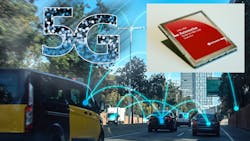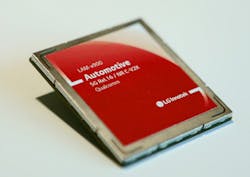Second-Gen 5G-V2X Module Boasts 150-Mb/s Download Speed
5G technology continues to receive more attention within the autonomous-driving field, due to the escalating need for immediate response to real-time change. Here’s the problem: When traffic is stuck due to an unexpected accident, this road condition has to be sent quickly to the advanced driver-assistance system (ADAS) in other cars to find an alternate route. But if data transmission is delayed, it opens the possibility of a secondary accident occurring because cars may not have the necessary information.
To prevent this situation, LG Innotek announced development of a second-generation 5G-V2X (vehicle-to-everything) cellular module. Based on Qualcomm chips, it’s said by LG Innotek to significantly improve long-distance data transmission and reception.
With the growing demand for autonomous-driving functions, industry watchers predict that the average load of data generated by a self-driving car will amount to about 4 TB, which is a capacity equivalent to downloading 8,000 films that are each 90 minutes long. When processing this enormous capacity of data, speed is the key.
Speed and Stability
The new module features a V2X data download speed of 150 Mb/s, more than 4X faster than the previous part’s 35 Mb/s. It’s ultimately aimed for use in autonomous driving. When driving at 100 km/h, it enables an ADAS system to detect an obstacle about 4X quicker than with an LTE chipset due to 5G’s low latency.
Also noteworthy, to minimize high-frequency 5G signal loss caused by direct sunlight and heat, LG Innotek upgraded its temperature control algorithm, offering stable 5G vehicle communication even at 194℉. Thanks to the increased durability, long-distance V2X communication (up to 1.5 km) can be stably supported through the 5G network.
This part can be mounted in the vehicle communication device inside the car or on the roof. The module combines a communication chip, memory, radio-frequency (RF) circuit, etc., to receive the large amount of data required for driving from the base station.
The cellular module measures 46 × 50 mm, which represents a 20% size reduction compared to the existing product. It’s half the size of a credit card, and thus can be mounted conveniently inside or outside the car.
Despite the reduced module size, the number of components mounted in the module has increased by over 60%—to 800—including the communication chip and memory, etc. The first-generation module has about 480 parts.
Byaeng-kuk Yoo, Vice President of LG’s Automotive Components & Electronics Business Unit, stated that the "second-generation 5G-V2X cellular module will become a key component in opening the period of fully autonomous driving.”
According to the market survey agency Techno System Research (TSR), the number of cars mounted with 5G communication modules globally is expected to increase from 1.7 million this year to 21.8 million by 2027.

